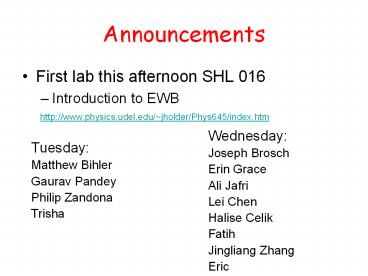Announcements PowerPoint PPT Presentation
1 / 21
Title: Announcements
1
Announcements
- First lab this afternoon SHL 016
- Introduction to EWB
http//www.physics.udel.edu/jholder/Phys645/index
.htm
Wednesday Joseph Brosch Erin Grace Ali Jafri Lei
Chen Halise Celik Fatih Jingliang Zhang Eric
Tuesday Matthew Bihler Gaurav Pandey Philip
Zandona Trisha
2
Lecture 2 Overview
- Kirchoffs Laws
- Power and Resistance
- Practical sources
- Voltage/ Current Dividers
- DC circuit analysis
- Element combination
- Using Kirchoffs Voltage Law
- Using Kirchoffs Current Law
- Mesh Analysis
3
Kirchhoff's three laws of spectroscopy 1. A
hot solid object produces light with a continuous
spectrum. 2. A hot tenuous gas produces light
with spectral lines at discrete wavelengths (i.e.
specific colors) which depend on the energy
levels of the atoms in the gas. (emission
spectrum) 3. A hot solid object surrounded by
a cool tenuous gas (i.e. cooler than the hot
object) produces light with an almost continuous
spectrum which has gaps at discrete wavelengths
depending on the energy levels of the atoms in
the gas. (absorption spectrum)
Gustav Robert Kirchhoff (12 March 1824 17
October 1887)
4
Kirchoffs Current Law
The sum of the current at any node must equal
zero i.e., the current flowing into a node must
equal the current flowing out of the node
Conservation of Charge (Current rate of change
of charge)
At Node 1 -ii1i2i30 ii1i2i3
Note convention current flows from positive
terminal In order for current to flow, there must
exist a closed circuit
5
Kirchoffs Voltage Law
The sum of the voltages around a closed loop is
zero
Potential at ava
bvb Potential difference v2va-vb
Around the loop -v1v20
v1v2
Note potential measured relative to ground true
ground (earth) or chassis ground (enclosure)
6
Circuit elements and their i-v characteristics
Resistor
Ohms law Current is proportional to applied
Voltage, and inversely proportional to the
Resistance VIR
v
R resistance depends on materials and
geometry ? resistivity depends only on
materials s conductivity
7
Resistor Color code
http//www.dannyg.com/examples/res2/resistor.htm
560KO 5
8
Electric Power
Electric power amount of work done/unit
time Voltage V work/unit charge So, to move
charge Q, work doneVQ Power VQ/t VI
PIV I2R V2/R
Units Joules/sec Watts (W) What do we pay for
in the electricity bill? kWhenergy/time time
energy
9
More on Power and Resistance
- What do the power ratings of appliances mean?
- e.g. what does a 1000W hair dryer tell us?
- Assume 120V (USA) if voltage not specified.
Max current
Never exceed the rated power
Can you use this appliance on a 240V (UK) line?
Destroys the appliance!
10
Resistance Limits Open and Short Circuits
- Short Circuit A wire! R0, V0 for any i.
- Particularly bad for any voltage source
- Open circuit A break! R??, i0 for any V.
- Particularly bad for current source
11
Series Resistors and the Voltage Divider Rule
For N resistors in series
REQgt(R1,R2,..,RN)
Voltage Divider
12
Practical Voltage Sources
Modelled with an ideal source and a series
resistor Ideal voltage source rS0 Current is
the same at all points
voltage divider
So for a practical voltage source, the output
voltage depends upon RL If rSltlt RL , vL vS ,
independent of RL
13
Parallel Resistors and the Current Divider Rule
For N resistors in parallel
REQlt(R1,R2,..,RN)
Current Divider
Large current through smaller R. Advantage of a
parallel circuit a broken branch will not affect
other branches
14
Practical Current Sources
Modelled with an ideal source and a parallel
resistor Ideal current source rS ?
current divider
The output current now depends upon RL If rSgtgt RL
, iL iS , independent of RL
15
Circuit analysis method 1Apply element
combination rules
Series resistors
Parallel resistors
Series voltage sources
Parallel current sources
16
Circuit analysis method 1 element combination
R22O I 10V/22O 0.45A
R110O R220O R330O V10V Find the equivalent
resistance and the current at I
17
Circuit analysis method 2a KVL and
KCLKirchoffs Voltage Law
The sum of the voltages around a closed loop must
be zero
- Draw the current direction (arbitrary) and
label the voltage directions (determined by the
defined current direction). Voltage on a voltage
source is always from positive to negative end. - Define either clockwise or counter-clockwise as
positive direction for summing voltages. Once the
direction is defined, use the same convention in
every loop.Voltage across a resistor is ve if
voltage direction the same as current direction,
-ve otherwise - Apply KVL
18
Kirchoffs Voltage Law Multiloop
The sum of the voltages around a closed loop must
be zero
- Draw the current direction (arbitrary) and
label the voltage directions (determined by the
defined current direction). - Define either clockwise or counter-clockwise as
positive voltage direction. Once the direction is
defined, use the same convention in every loop. - Apply KVL
19
Kirchoffs Current Law
The sum of the current at a node must be zero
IinIout
II2I3 (1)
eIrIR1I2R2 (2)
I3R3-I2R2 0 (3)
Set r1O, R13O, R25O, R310O, e3V
I- I2- I3 0 (4)
4I5I2 0I3 3 (5)
0I- 5I210I3 0 (6)
20
Last note on KCL KVL analysis
- If solutions to currents or voltages are
negative, this means the real direction is
opposite to what you originally defined - To deal with current sources current is known,
but assign a voltage across it which has to be
solved
21
Sample Problem

